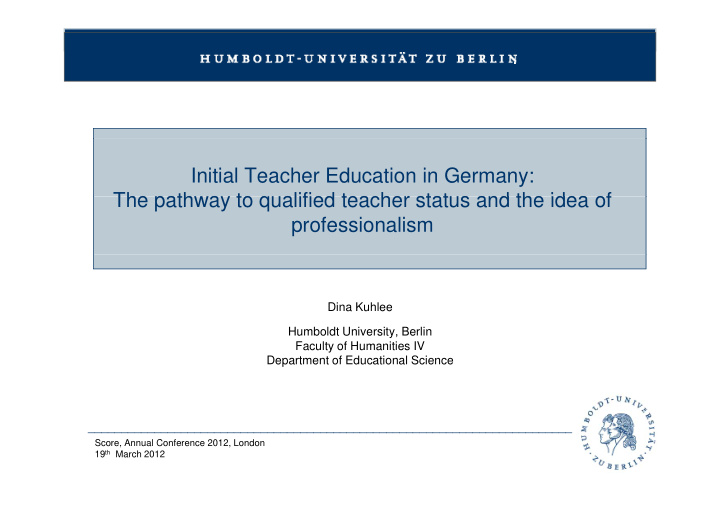



Initial Teacher Education in Germany: The pathway to qualified teacher status and the idea of The pathway to qualified teacher status and the idea of professionalism Dina Kuhlee Humboldt University, Berlin Faculty of Humanities IV Department of Educational Science _________________________________________________________________________ Dina Kuhlee Score, Annual Conference 2012, London 19 th March 2012
Overview 1. The structure of Initial Teacher Education in Germany: The pathway to qualified teacher status 2. Teaching as a profession: Some key thoughts 3. Teacher shortages: The search for alternative routes 4 4. Summary Summary _________________________________________________________________________ Dina Kuhlee
The structure of Initial Teacher Education: The pathway to qualified teacher status Programme for teacher students (upper secondary level) (1) Bachelor of Arts / Bachelor of Science (3 years; 180 ECTS/CP) – Students choose two subjects as majors for their study programme (academic subject knowledge) (150 CP) – Students take lectures in subject-specific pedagogy for each major and general pedagogy/educational science (pedagogical knowledge) (30 CP) (2) Master of Education (2 years; 120 ECTS/CP) – Students follow their chosen subjects as majors for their Master’s programme (35 CP) – Students take lectures in subject-specific pedagogy for each major and general pedagogy/educational science (pedagogical knowledge) (70 CP) (Thesis 15 CP) (3) Teaching practice ( Referendariat ) (2 years) – Students acquire practical teaching skills in their subjects under the supervision of a senior teacher (mentor) t h ( t ) – Students take courses in general pedagogy and subject-specific pedagogy and are examined at the end of the 2 years Fully qualified teachers work in schools and traditionally have civil servant status . _________________________________________________________________________ Dina Kuhlee
Teaching as a profession: Some key thoughts (1) Development of teaching expertise: BA/MEd university- Career entry Further Practical ITE in based ITE teaching schools experience Theoretical knowledge Experiential Guided experiential p (focused on potential (focused on potential knowledge knowledge, E Experienced i d knowledge for practical problem - building up teacher solving ) expertise 5 years 5 years 7 years 7 years 10 12 years 10 -12 years Expertise is generated by years of learning, targeted practice, professional support and feedback ( Ericsson et al. 2006 ) (2) Teaching (2) Teaching – Planning the unprojectable ( Gage 1972 ): “Planning the unprojectable” ( G 1972 ): Planning of Implementing Evaluation lesson (building /giving lesson (analytical hypotheses) (immediate reflection ) adaptation of plans) Reflective analysis connected to different kinds of theoretical knowledge to avoid getting lost in one’s own pool of experiences . lost in one s own pool of experiences . _________________________________________________________________________ Dina Kuhlee
Teacher shortages: The search for alternative routes � Due to demographic factors the expected demand for teachers (constant number of appointments) ( cf. Klemm 2009 ) is: – until 2015/16: 38,000 teachers per year – from 2016 - 2020/21: 32,000 teachers per year – only ca. 26,000 newly & fully qualified teachers per year enter teaching l 26 000 l & f ll lifi d t h t t hi � There is a particular shortage of teachers in MINT (STEM) subjects (the current discussion already relates to between 20,000 and 30,000 teachers) Alternative pathways into teaching (fixed-term/temporary solutions) ( cf. Korneck & Lamprecht 2010 ): � Programmes for career changers in each Federal State from 2000 until ca. 2016: (1) Career changers entering mentored practical teaching ( Referendariat , 2 years) ( Quereinstieg ) (2) Career changers joining special training programmes on the job while teaching reduced time-tables ( Seiteneinstieg ) ( g ) Pre-condition: Successful study (B.A./BSc. and M.A./M.Sc.) of the relevant subjects _________________________________________________________________________ Dina Kuhlee
Summary ITE in Germany combines academic education and practical training, where substantial subject knowledge, subject-specific pedagogical knowledge and general pedagogical knowledge are pre-conditions for practical training in schools. The main pedagogical knowledge are pre conditions for practical training in schools. The main aim of German ITE is to ensure a certain standard of teaching over all schools and subjects and over time. _________________________________________________________________________ Dina Kuhlee
References Klemm, K. (2009). Zur Entwicklung des Lehrerinnen- und Lehrerbedarfs in Deutschland. Essen, 2009. Korneck F & Lamprecht J (2010) Quer- und Seiteneinsteigerinnen in den Lehrberuf – eine Analyse exemplarisch am Lehramt für das Fach Korneck, F. & Lamprecht, J. (2010). Quer- und Seiteneinsteigerinnen in den Lehrberuf – eine Analyse exemplarisch am Lehramt für das Fach Physik. In Journal für die LehrerInnenbildung, 10 (3), 8-21. Standing Conference of Ministers of Education (KMK) (2007): Ländergemeinsame Strukturvorgaben für die Akkreditierung von Bachelor und Masterstudiengängen. Beschluss der Kultusministerkonferenz vom 10.10.2003 i.d.F. vom 04.02.2010, http://www.kmk.org/fileadmin/veroeffentlichungen_beschluesse/2003/2003_10_10-Laendergemeinsame-Strukturvorgaben.pdf. Ericsson, K.A., Charness, N., Feltovich, P.J. & Hoffmann, R.R. (Eds.) (2006): The Cambridge Handbook of Expertise and Expert Performance. Cambridge: Cambridge Unievrsity Press. Gage, N.L. (1972). Unterrichten – Kunst oder Wissenschaft?München: Urban & Schwarzer. _________________________________________________________________________ Dina Kuhlee
Current situation for MINT subjects (general) Current situation for MINT subjects (general) By 2020 there will be an expected shortage of workforce employees with MINT- Qualifications: ca. 230,000 (‘ Fachkraeftemangel’ , cf. Pluenneke & Koppel 2009) Due to rising replacement demand (e.g. Engineering: from 2011: ca. 43,000 per year: e g Mathematics/Natural sciences: from 2010: ca 18 000 per year) year: e.g. Mathematics/Natural sciences: from 2010: ca. 18,000 per year) as well as to skill-based technological change (50,000 per year) (cf. Pluenneke & Koppel 2009; Bonin et al. 2007). Enhanced by a rising percentage of industry- based production with regard to national income. Demand for graduates per year: ca. 113,000 Number of graduates per year: ca 90 000 Number of graduates per year: ca. 90,000
Recommend
More recommend